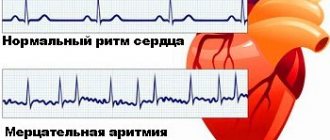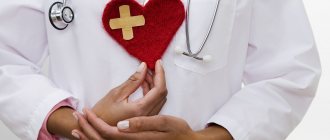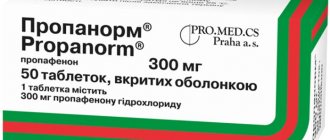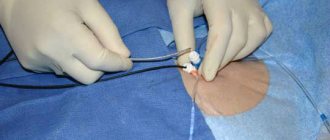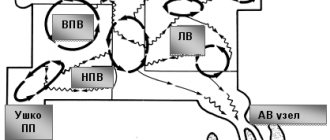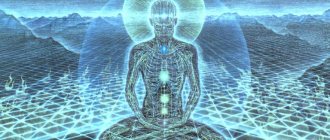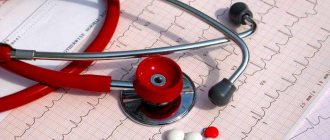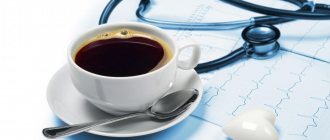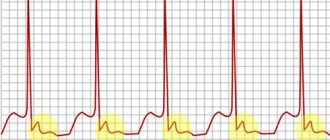Arrhythmia refers to disturbances in the rhythm, frequency, and sequence of heartbeats. This pathology may indicate more severe cardiac diseases (heart defects, heart attacks, heart failure), as well as a disorder of the autonomic nervous system, and the spread of infection in the body. Heartbeat disorders occur in healthy people after taking certain medications, a fair amount of alcohol, smoking, caffeine-containing drinks, or due to fatigue.
Treatment of arrhythmia is prescribed after identifying predisposing factors, determining the type and stage of the disease. Diagnostics includes procedures such as electrocardiogram, Holter monitoring, ultrasound, electrophysiological studies, and stress tests. In cardiology today it is customary to classify the disease depending on the frequency of contractions and rhythm of the heart. In accordance with these criteria, the following are distinguished:
- tachycardia - rapid heartbeat;
- bradycardia - slow;
- extrasystole - extrarhythmic contractions;
- atrial fibrillation - contraction of individual muscle fibers.
Treatment tactics are determined taking into account these types of arrhythmias and the severity of clinical manifestations.
Drug therapy is developed if characteristic symptoms appear: shortness of breath, fatigue, rapid heartbeat, etc. The cardiologist, as a rule, prescribes antiarrhythmic drugs. They are divided into several classes:
- designed to block sodium channels of the cell membrane (this group includes gilurythmal, quinidine sulfate, lidocaine, pyromecaine, propafenone, aprindin);
- reduce the influence of adrenergic impulses (metoprolol, propranolol, nebivolol, timolol);
- increase the duration of the action potential of the refractory period (the main representatives are amiodarone, dofetilide, nibentan);
- aimed at blocking slow calcium channels (verapamil, bepridil, etc.).
All medications must be used in strict accordance with the instructions and recommendations of the doctor, since incorrect dosage and mode of use can cause a decrease in blood pressure and worsen the current condition.
Electrical pulse therapy or EIT is an effective way to treat various types of arrhythmias using electric current. It is used to relieve tachycardia, with the development of heart failure, deterioration of blood supply to the heart and brain, and is necessary in critical conditions. Planned therapy is prescribed when medications are ineffective.
An electric current is produced by a defibrillator, which delivers a shock at a certain point in the heart's activity. During the procedure, 2 electrodes are placed tightly in the chest or directly on the heart area. The magnitude of the discharge varies from 200 to 360 J with external or 12.5-25 J with internal EIT. For pain relief, short-acting anesthesia is recommended to speed up the recovery period.
If cardiac dysfunction is persistent, in the treatment of arrhythmia it is necessary to change lifestyle, normalize diet, and avoid stressful situations. Regular consultations with a cardiologist and dynamic monitoring are required.
Causes and signs of arrhythmia
Arrhythmia is a pathological condition in which the heart rate is disturbed
Rhythm disturbances are one of the most common cardiac pathologies. Arrhythmia can be either a separate disease or one of its manifestations. Most often, arrhythmia occurs against the background of an existing disease. The most common is atrial fibrillation, in which different parts of the myocardium contract at different speeds, frequency and intensity.
Rhythm restoration with electric current discharge is carried out only if other methods of combating arrhythmia do not help. The heart contracts in such a way that blood flows most productively into the arteries and veins. If the muscle fibers of the atria begin to contract chaotically, the pumping function of the heart decreases, blood does not flow into the ventricles and then into the arteries, which leads to various complications.
Since rhythm disturbances are usually the result of various diseases, this condition can occur for the following reasons:
- Ischemia and myocardial infarction. Coronary heart disease often leads to a heart attack, since it is accompanied by oxygen starvation of the myocardium, which can provoke tissue death. In this case, blood flow to the myocardium is disrupted, which provokes arrhythmia.
- Drinking large doses of alcohol. Alcohol negatively affects the condition of the heart and blood vessels. When drinking a large amount of alcoholic beverages, an attack of arrhythmia develops. If you already have serious cardiovascular disease, this condition can be fatal.
- Hormonal disorders. In people with thyroid disease, diabetes and other hormonal problems, heart rhythm disturbances are quite common. Hormonal levels are responsible for the functioning of many internal organs, so disruptions lead to serious complications.
- Atrial fibrillation can be asymptomatic and detected only during examination (ECG). Signs of arrhythmia are discomfort in the chest and tachycardia. A person feels heart fluttering, rapid heartbeat, freezing, etc.
Read also: Arrhythmia folk treatment
How to restore heart rhythm during atrial fibrillation at home?
Atrial fibrillation is a fairly common phenomenon among cardiac pathologies. In this condition, the rhythm of contraction and relaxation of the myocardium is disrupted. The disease is characterized by atrial contraction frequency from 300 to 700 beats per minute. How to restore heart rhythm during arrhythmia at home? Let's try to figure it out.
How to restore heart rhythm
Why is arrhythmia dangerous?
An increased heart rate is observed in various situations: during nervous excitement, emotional, and physical stress. Heart rhythm disturbance in this case is a temporary phenomenon that goes away on its own, without help. Whereas with atrial fibrillation, restoration of sinus rhythm is required.
What should you do if your pulse quickens and your heart pounds in your chest for no reason? The first thing to do is call an ambulance. You should not take your health lightly, because the heart does not work properly with atrial fibrillation.
The greatest danger of the pathology is that with atrial fibrillation, blood stagnation occurs, and this leads to the formation of a blood clot. The broken blood clot enters the aorta through the bloodstream and is then transported to the brain.
Every effort must be made to restore the heart rhythm, since disturbances in the blood supply to the body can cause cardiac arrest.
Arrhythmia can occur suddenly and go away just as quickly, but this is an alarming signal, so you should not ignore it. It would be a good idea to consult a cardiologist, especially if you have already had heart problems.
Restoration of sinus rhythm
In case of arrhythmia attacks, you need to call a doctor, and before his arrival, provide assistance to the patient:
- During an attack of arrhythmia, you need to put the patient on the sofa. If this happened on the street, you need to find a bench and sit the person on it.
- It is important to reassure the patient and refrain from any negative information.
- It is necessary to provide access to fresh air in the room where the patient is located. If any accessory is squeezing your neck, it must be removed.
- To restore the heart rhythm, ask the patient to hold his breath for 15-20 seconds, then clear his throat.
- Vomiting can help with an attack of arrhythmia. It is easy to cause by pressing on the root of the tongue. Such manipulations restore heart rhythm.
- During an attack, you should wash the patient's face and give him cool water to drink. It is even better if the patient immerses his face in a container of cold water.
- You can give the patient a stale crust of black bread to eat, this will help alleviate his condition somewhat.
Important! If the flickering arrhythmia has become permanent, restoring sinus rhythm without medical help is impossible. Long-term hospital treatment under medical supervision is required.
While waiting for the ambulance to arrive, a patient with arrhythmia can be given a drug belonging to the group of beta-blockers:
- Anaprilin;
- Concor;
- Egilok and others.
DETAILS: Erinit indications for use reviews
Restoring sinus rhythm with drugs
Restoration of sinus rhythm must be achieved within the first 48 hours after the onset of the attack. If the arrhythmia persists for more than two days, echocardiography is performed. The atria are examined for the presence of blood clots (thrombi).
To stop an attack of arrhythmia, intensive cardiological therapy is used. Sometimes only cardioversion helps. Indications for such measures are acute heart failure, arterial hypotension in patients with cardiac ischemia.
To restore the heart rhythm, two methods are used:
- medications;
- electrical influence.
In what cases is electric shock required?
Electric current discharge is indicated for fibrillation and tachyarrhythmia
Elimination of heart rhythm disturbances using an electrical impulse is called cardioversion. It is performed differently depending on the patient's condition and the urgency of the procedure.
As you know, the heart contracts thanks to the sinus node, which supplies electrical impulses and causes contraction of the myocardium. Cardioversion works on the same principle. With the help of current, the heart is forced to contract in the desired rhythm and at the required frequency.
This procedure may have consequences and contraindications; in emergency cases (cardiac arrest), it is mandatory, since it is part of resuscitation procedures.
Cardioversion is required in the following cases:
- Atrial fibrillation. In this case, impulses to the myocardium arrive unevenly, muscle fibers contract very quickly and chaotically, while being unproductive. The cause may be cardiac pathologies (heart failure, cardiosclerosis, heart disease). The risk of sudden death with atrial fibrillation is very high, so cardioversion is often recommended.
- Ventricular fibrillation. This is a dangerous condition in which the walls of the ventricles contract at a high frequency (300 beats per minute), but the pumping function of the heart stops. Blood does not flow to organs and tissues, which leads to the death of the patient within 10 minutes if medical assistance is not provided.
- Atrial tachycardia. Atrial tachycardia is quite common, especially in older people. As a rule, the prognosis is favorable. This disease is not considered life-threatening, but in some cases complications and further rhythm disturbances occur that need to be corrected with electric current.
- Ventricular tachycardia. This is one of the most unfavorable rhythm disturbances that occur during myocardial infarction. The risk of sudden cardiac arrest is very high, so the patient requires urgent medical attention.
Cardioversion can also be prescribed routinely. In this case, the patient is prepared for the procedure.
Features of cardioversion
A heart that has stopped suddenly can be started using a defibrillator
The essence of cardioversion is to deliver an electrical discharge through electrodes attached to the patient's chest. An abnormal heart rhythm can be very life-threatening as it leads to poor circulation to other organs, including the brain.
As a rule, this is due to the fact that the sinus node is not capable of delivering full impulses to contract the myocardium. To correct the situation, a defibrillator is used.
Planned cardioversion is carried out according to the following algorithm:
- The patient is examined, an ECG is done, the diagnosis is clarified and the need for cardioversion is confirmed.
- Preparation is a must. To avoid blood clots, the patient takes anticoagulants for some time before the procedure to reduce blood clotting.
- The procedure is performed on an empty stomach, so it is not recommended to eat on the day of cardioversion.
- Anesthesia is used to put the patient to sleep, and then a defibrillator is used to deliver 1 or more electric shocks to normalize the heart rhythm.
- After the procedure, the patient is transferred to intensive care and observed for some time.
The procedure itself lasts no more than half an hour. Pain is not felt due to anesthesia. The patient will still need special care for some time.
If emergency medical attention is required due to cardiac arrest, a portable defibrillator is used.
First you need to make sure that the patient is really having an attack and is not breathing. Then the chest is prepared, wiped dry, and 2 electrodes are attached to it. It is very important that the skin is dry. Often a razor is included in the kit, since chest hair reduces the strength of the electrical impulse. Electrodes are attached in the center of the chest and under the left breast.
More information about how a defibrillator works can be found in the video:
Make sure the defibrillator is turned on and the electrodes are connected correctly. Electric current can only be applied if no one is touching the patient. After this, you need to press the shock button. The portable defibrillator automatically analyzes your heart rhythm and recommends a shock.
Read also: Arrhythmia of movement
Indications for the procedure
If the patient has an abnormal heart rhythm, arrhythmia or atrial flutter, electric shock may be prescribed. The discharge must be synchronized - otherwise there is a risk of not only conducting an ineffective procedure, but also causing serious complications. Doctors identify several indications for cardioversion:
- Drug therapy turned out to be ineffective, while the arrhythmia progresses, and the person has concomitant diseases - hypotension, heart failure, stroke. Delay has other consequences;
- There is an arrhythmia with SVC syndrome, that is, there is a risk of ventricular arrest;
- Symptoms of the pathology are pronounced and poorly tolerated by the patient;
- An allergic reaction to medications has occurred, or it is impossible to take them for some reason;
- After drug treatment, a relapse occurs after a short period of time;
- A persistent form of atrial fibrillation - the rhythm has been disturbed for a long time, the doctor decided on complex therapy - both drugs and electric current at the same time.
The procedure is performed for all types of rhythm disturbances, including atrial fibrillation and flutter. The activity of the sinus node weakens or stops altogether.
The procedure is carried out in the intensive care unit using a device that transmits electric current - a cardioverter. Two electrodes are applied to the patient's body - one on the chest, the other on the back in the area of the left shoulder blade.
Immediately after application, the device allows you to read the cardiogram of the heart on a small window. When performing an intervention, there is a risk of complications; in this case, the doctor must prepare an intubation tube, adrenaline solution, and other emergency aid.
How is cardioversion performed?
- The patient is given anesthesia - general anesthesia is given;
- A catheter is placed in the vein to provide easy access;
- The chest and collarbone area is wiped with alcohol for better contact;
- The electrodes are treated with gel and applied to the chest and back;
- Heart rate synchronization occurs;
- The first discharge is carried out with a power of 50 J;
- Changes are observed on the device screen;
- If there is no effect, the pulses are repeated with increased current strength - 100 and 200 J;
- If there is no effect, a drug for arrhythmia is administered;
- In the case when fibrillation is not eliminated, a shock of 360 J is given, the medicine is administered again, then a second discharge.
If atrial fibrillation persists, the treatment turned out to be ineffective - no additional manipulations are performed. The procedure itself is not felt by the patient in any way, the manipulations take from several minutes to an hour - due to the body’s response, it is not a treatment.
Irregular heart rhythm can be life-threatening for the patient. In some cases, the patient is unaware of the presence of arrhythmia, in others, this condition leads to a serious attack requiring immediate medical attention.
If the heart rhythm is disrupted to such an extent that the likelihood of death increases, doctors resort to using a defibrillator. Before using this measure, you must ensure that it is necessary.
Arrhythmia is a pathological condition in which the heart rate is disturbed
Rhythm disturbances are one of the most common cardiac pathologies. Arrhythmia can be either a separate disease or one of its manifestations. Most often, arrhythmia occurs against the background of an existing disease.
Rhythm restoration with electric current discharge is carried out only if other methods of combating arrhythmia do not help. The heart contracts in such a way that blood flows most productively into the arteries and veins.
Since rhythm disturbances are usually the result of various diseases, this condition can occur for the following reasons:
- Ischemia and myocardial infarction. Coronary heart disease often leads to a heart attack, since it is accompanied by oxygen starvation of the myocardium, which can provoke tissue death. In this case, blood flow to the myocardium is disrupted, which provokes arrhythmia.
- Drinking large doses of alcohol. Alcohol negatively affects the condition of the heart and blood vessels. When drinking a large amount of alcoholic beverages, an attack of arrhythmia develops. If you already have serious cardiovascular disease, this condition can be fatal.
- Hormonal disorders. In people with thyroid disease, diabetes and other hormonal problems, heart rhythm disturbances are quite common. Hormonal levels are responsible for the functioning of many internal organs, so disruptions lead to serious complications.
- Atrial fibrillation can be asymptomatic and detected only during examination (ECG). Signs of arrhythmia are discomfort in the chest and tachycardia. A person feels heart fluttering, rapid heartbeat, freezing, etc.
DETAILS: Sinus bradycardia of the heart in an 8-year-old child
Electric current discharge is indicated for fibrillation and tachyarrhythmia
Elimination of heart rhythm disturbances using an electrical impulse is called cardioversion. It is performed differently depending on the patient's condition and the urgency of the procedure.
As you know, the heart contracts thanks to the sinus node, which supplies electrical impulses and causes contraction of the myocardium. Cardioversion works on the same principle. With the help of current, the heart is forced to contract in the desired rhythm and at the required frequency.
This procedure may have consequences and contraindications; in emergency cases (cardiac arrest), it is mandatory, since it is part of resuscitation procedures.
Cardioversion is required in the following cases:
- Atrial fibrillation. In this case, impulses to the myocardium arrive unevenly, muscle fibers contract very quickly and chaotically, while being unproductive. The cause may be cardiac pathologies (heart failure, cardiosclerosis, heart disease). The risk of sudden death with atrial fibrillation is very high, so cardioversion is often recommended.
- Ventricular fibrillation. This is a dangerous condition in which the walls of the ventricles contract at a high frequency (300 beats per minute), but the pumping function of the heart stops. Blood does not flow to organs and tissues, which leads to the death of the patient within 10 minutes if medical assistance is not provided.
- Atrial tachycardia. Atrial tachycardia is quite common, especially in older people. As a rule, the prognosis is favorable. This disease is not considered life-threatening, but in some cases complications and further rhythm disturbances occur that need to be corrected with electric current.
- Ventricular tachycardia. This is one of the most unfavorable rhythm disturbances that occur during myocardial infarction. The risk of sudden cardiac arrest is very high, so the patient requires urgent medical attention.
Cardioversion can also be prescribed routinely. In this case, the patient is prepared for the procedure.
Electrical cardioversion is a procedure used to treat irregular heart rhythms. It involves the use of an electrical discharge to stop an attack of arrhythmia.
The procedure is recommended or possible if:
- chronic or paroxysmal atrial fibrillation for more than 48 hours;
- acute heart failure;
- intolerance or ineffectiveness of antiarrhythmic drugs;
- atrial fibrillation without serious signs of impaired blood flow through the vessels;
- increased frequency of relapses (more than three within six months), despite the use of antiarrhythmic drugs.
Electropulse therapy is contraindicated in the following cases:
- tachyarrhythmia as a result of an overdose of cardiac glycosides;
- severe alcohol poisoning;
- uncompensated heart failure (excluding emergency situations);
- hyperthyroidism to a decrease in the level of hormones produced by the thyroid gland;
- thrombus in the left atrium;
- hypokalemia;
- impossibility of using general anesthesia;
- complete cardioventricular block.
Two factors are believed to be responsible for the risk of embolism:
- An existing thrombus in the left atrium or in its appendage breaks off due to atrial contractions.
- Against the background of CV, there is a decrease in the function of the left atrium and a deterioration in blood flow, which leads to the formation of a blood clot.
DETAILS: What causes high blood pressure
Due to the increased risk of blood clots, antithrombolic drugs are mandatory. It is required to maintain an INR of 2.0–3.0 (the required level of blood clotting) for 3–4 weeks.
Restoration of heart rhythm by electric current under the control of transesophageal echocardiography is used as an alternative when there is an increased threat of thrombus formation in the left atrium or in its appendage, there is a risk of bleeding during anticoagulation, or early CV is required.
If a thrombus was not detected during transesophageal echocardiography, then the mandatory 21-day anticoagulant therapy can be reduced. If a blood clot is found, treatment with warfarin and other vitamin K antagonists is carried out and TEE is repeated. After the thrombus dissolves, CV is allowed.
Recommendations for preventing blood clots must be followed regardless of the type of cardioversion.
The patient is considered prepared for the procedure if the following conditions are met:
- the patient is aware of possible complications and has given written consent to perform the procedure;
- potassium content in the blood is 4.5–5.0 mmol/l (for hypokalemia, a glucose-potassium mixture is prescribed intravenously);
- INR {amp}gt; 2.0;
- hair must be removed at the site where the plates are applied;
- the patient did not consume solid food or water for 6 hours before the CT.
In special cases, immediate CV is required, regardless of anticoagulant status. Unscheduled CV is carried out if atrial fibrillation is the main factor in the formation of heart failure, hypotension, and aggravation of angina pectoris.
Why is arrhythmia dangerous?
Arrhythmia can cause a heart attack
Defibrillation itself can lead to some complications. For example, after the procedure, the arrhythmia returns, the heart rhythm is disturbed even more, and with a strong discharge, the heart muscle can be damaged.
But cardioversion is prescribed only when the likelihood of the patient dying without it is very high.
Arrhythmia can lead to a number of dangerous consequences:
- Thromboembolism. In this condition, the vessel is blocked by the resulting blood clot. Blood clots can form in the vessels of the brain, lungs, and lower extremities. Complications depend on the location and size of the blood clot. The disease may not manifest itself in any way until the blood clot blocks more than 80% of the lumen of the vessel. If a blood clot forms in the vessels of the lungs, it leads to respiratory failure. In most clinical cases, when the arteries and vessels of the lungs become blocked, death occurs.
- Heart failure. This is a condition in which the contractility of the heart decreases for one reason or another. It is one of the most common causes of death in the world. Acute heart failure can lead to cardiogenic shock, chronic heart failure can lead to hypoxia of all internal organs. This disease is progressive.
- Stroke. As a rule, a stroke is caused by ischemia, a blockage of a brain vessel by a blood clot or plaque. Blood circulation to a certain area of the brain is stopped, which leads to serious, often irreparable consequences.
It must also be remembered that a serious disturbance in heart rhythm can lead to sudden death of the patient. Even a mild arrhythmia can result in serious consequences. This is due to the fact that in this condition the blood is pumped poorly and stagnates in the arteries, which provokes the formation of blood clots. Because a blood clot is attached to the wall of a vessel or artery on only one side, over time it can break off and block a vital artery, leading to sudden death.
All types of arrhythmias are dangerous: bradyarrhythmia and tachyarrhythmia. Bradyarrhythmia in some cases requires the installation of a pacemaker.
If your heart flutters
Sometimes you walk a little faster, and your heart beats in your chest like a bird or trembles like an autumn leaf, and sometimes, on the contrary, it freezes and you can’t hear it. What is this? In medical parlance, this is called cardiac arrhythmia. With arrhythmia, heart contractions become abnormal and irregular. Andrei Pishch, a general practitioner at the Gantsevichi Central District Hospital, told GCH about why arrhythmia occurs and why it is dangerous. Edit
Stories about how a man on the street suddenly fell and died involuntarily force us to talk about the intervention of other forces. However, doctors know the very real causes of sudden deaths. One of them is a heart rhythm disorder - arrhythmia. Should you always be afraid of it and how to treat it - the head of the outpatient department of the Clinic of Faculty Therapy and Interventional Cardiology named after. V. N. Vinogradov Moscow Medical Academy named after. I. M. Sechenova Ph.D. Anton RODIONOV.
In order for the heart to beat, or rather to contract, special heart cells produce and conduct electrical impulses. The triggering signal occurs in the right atrium (one of the upper parts of the heart), in the so-called sinus node - the pacemaker. It is responsible for the fact that the heart contracts at a rate of 60–90 beats per minute.
The signal then travels to the left atrium and then to the ventricles (lower chambers of the heart). Contractions follow each other at regular intervals. Any violations of their frequency, sequence and are united by the concept of “arrhythmia”. Many of them are safe and even natural for a healthy person.
For example, sinus or respiratory arrhythmia: when inhaling, the pulse slows down, while exhaling it increases. An increase in heart rate during physical or emotional stress, or an increase in body temperature is also a normal reaction of a healthy heart. Single estrasystoles are considered within normal limits - rare extraordinary contractions that can be felt as interruptions. Each person can have up to several dozen of them per day.
BUT THERE IS also a large group of formidable and even life-threatening arrhythmias. When the heart rate is too slow - bradycardia (pulse less than 50 beats per minute), the heart is not able to pump enough blood. This can lead to fatigue, dizziness, and loss of consciousness. With severe “heart block,” the heart contracts very slowly, which is why the organs, and especially the brain, do not receive enough oxygen. In this situation, the patient needs urgent installation of a pacemaker.
With frequent contractions - tachycardia (pulse exceeds 100 beats per minute), the work of the heart becomes less efficient and the delivery of oxygen to organs and tissues also decreases. Sometimes the pulse can reach 150–200 beats per minute, which is manifested by shortness of breath, chest pain, often loss of consciousness, and in severe situations the death of the patient is possible.
With atrial fibrillation, contraction of the atria - when their muscle fibers lose the ability to work synchronously, the atria only twitch chaotically - flicker. As a result, the ventricles begin to contract irregularly. This can be felt as an irregular heartbeat and pounding in the chest. The non-contracting heart muscle further weakens and stretches, which can lead to heart failure and stroke.
We are looking for the guilty
https://www.youtube.com/watch?v=Glrmaj7yq-s
USUALLY, if an arrhythmia appears after 50 years of age, doctors do not particularly rack their brains about where it came from. Natural age-related processes (for example, the growth of connective tissue in the heart muscle) lead to changes in the conductivity of electrical impulses. Arrhythmia in young people can be a consequence of rare congenital or hereditary diseases, or a previous infectious disease, for example myocarditis. Sometimes the cause of arrhythmia is increased thyroid function.
caffeine, tobacco, alcohol, cold and cough suppressants, appetite suppressants, psychotropic drugs, drugs such as cocaine and marijuana.
In cases where the cause of rhythm disturbances cannot be eliminated (except for cases such as: “Don’t drink!”, “Don’t smoke!”), antiarrhythmic treatment has to be carried out.
IF you have ever felt the symptoms of arrhythmia - a feeling of extra or missed heart beats, freezing, turning over, too fast or slow heartbeat, "fluttering" in the chest or neck, weakness, shortness of breath and pain in the heart - it is advisable to be examined by a cardiologist. Even if the arrhythmia went away on its own.
It can return at any time and lead to serious complications. It is worth calling an ambulance when the arrhythmia does not go away for several hours. The easiest way to find out how dangerous heart failure is is to record an electrocardiogram (ECG). Rare arrhythmias can be detected using 24-hour monitoring, when the patient puts on a small device the size of a modern player and attaches 5-7 electrodes to the chest.
IF you get panicky from 2-3 small interruptions a day, your doctor will likely recommend that you take anti-anxiety medication to simply lessen your reaction to the unfortunate beat. In more serious situations, you will have to take antiarrhythmic drugs. The main thing is to do it exactly as prescribed and not stop treatment without consulting your doctor.
For some types of arrhythmia, a non-drug method, radiofrequency ablation, helps. A catheter is inserted into the heart, the place responsible for the rhythm disturbance is located, and this zone is destroyed using radio frequency. After this procedure, the person leaves practically healthy.
• Keep a special calendar where you make notes every time you take your next dose (or when you need to go to the pharmacy).
• Post a reminder note on your refrigerator.
• You can use special timers (for example, in mobile phones) that will remind you of the time to take the medicine.
Yulia BORT
Photo by Eduard KUDRYAVITSKY
Indications and contraindications
The procedure is recommended or possible if:
- chronic or paroxysmal atrial fibrillation for more than 48 hours;
- acute heart failure;
- intolerance or ineffectiveness of antiarrhythmic drugs;
- atrial fibrillation without serious signs of impaired blood flow through the vessels;
- increased frequency of relapses (more than three within six months), despite the use of antiarrhythmic drugs.
Electropulse therapy is contraindicated in the following cases:
- tachyarrhythmia as a result of an overdose of cardiac glycosides;
- severe alcohol poisoning;
- uncompensated heart failure (excluding emergency situations);
- hyperthyroidism to a decrease in the level of hormones produced by the thyroid gland;
- thrombus in the left atrium;
- hypokalemia;
- impossibility of using general anesthesia;
- complete cardioventricular block.
Atrial fibrillation
It happens that “the heart beats in the chest like a bird” or “like an autumn leaf trembles.” And sometimes “it will clog up, then it will freeze.”
In medical language, all this is called cardiac arrhythmia. Heart contractions become irregular and irregular. There are different types of arrhythmias, but one of the most common is atrial fibrillation.
It is known that with each heartbeat there is a sequential contraction of its parts - first the atria, and then the ventricles. Only such alternation ensures efficient functioning of the heart. With arrhythmia, which has received the beautiful name “atrial fibrillation,” one of the phases of the cardiac cycle disappears, namely, atrial contraction. Their muscle fibers lose the ability to work synchronously. As a result, the atria only twitch chaotically - flicker. As a result, the ventricles begin to contract irregularly.
Preparing for planned heart rhythm restoration
Two factors are believed to be responsible for the risk of embolism:
- An existing thrombus in the left atrium or in its appendage breaks off due to atrial contractions.
- Against the background of CV, there is a decrease in the function of the left atrium and a deterioration in blood flow, which leads to the formation of a blood clot.
Due to the increased risk of blood clots, antithrombolic drugs are mandatory. It is required to maintain an INR of 2.0–3.0 (the required level of blood clotting) for 3–4 weeks.
Restoration of heart rhythm by electric current under the control of transesophageal echocardiography is used as an alternative when there is an increased threat of thrombus formation in the left atrium or in its appendage, there is a risk of bleeding during anticoagulation, or early CV is required.
If a thrombus was not detected during transesophageal echocardiography, then the mandatory 21-day anticoagulant therapy can be reduced. If a blood clot is found, treatment with warfarin and other vitamin K antagonists is carried out and TEE is repeated. After the thrombus dissolves, CV is allowed.
Recommendations for preventing blood clots must be followed regardless of the type of cardioversion.
The patient is considered prepared for the procedure if the following conditions are met:
- the patient is aware of possible complications and has given written consent to perform the procedure;
- potassium content in the blood is 4.5–5.0 mmol/l (for hypokalemia, a glucose-potassium mixture is prescribed intravenously);
- INR > 2.0;
- hair must be removed at the site where the plates are applied;
- the patient did not consume solid food or water for 6 hours before the CT.
Read also: Valocordin for arrhythmia
Drug treatment
It is necessary to treat the disease that caused disturbances in the functioning of the heart.
To know how to cure cardiac arrhythmia, you need to determine in which area the work is impaired. Depending on the location of the violation, the following types are distinguished:
- atrial;
- ventricular;
- sinus.
The disease is classified not only by the location of the disorder. There are a few more signs. The classification system is complex, and the treatment method depends on it.
Is it possible to treat cardiac arrhythmia with medication? Successful elimination of the disease and symptoms depends on timely contact with a specialist.
Depending on the type of disease, different groups of medications are prescribed.
The most commonly used drugs for arrhythmia are:
| Propaphenone | |
| Sotohexal | |
| . | Cordaron |
But the most popular are beta blockers. They are also used for tachycardia because they reduce heart rate. These are drugs that affect the nervous system. Over the past half century, they have become increasingly used in cardiology and in the drug treatment of arrhythmia.
Beta blockers vary in composition and therefore have different mechanisms of action. They are used during or after meals. This is a must because it reduces the risk of side effects.
Important! Before use, you should not only consult a doctor, but also be observed by him during the entire course of treatment with the drug.
During the treatment period, it is necessary to monitor your pulse. If the patient notices that the heart rate is below the desired level, he should immediately inform the doctor.
Taking medications during pregnancy is dangerous. You need to coordinate this with your doctor. Pregnancy planning also plays an important role.
Sometimes arrhythmia is caused by the use of medications. In this case, the doctor will reduce the dosage or replace the drug.
Emergency electrical HF
In special cases, immediate CV is required, regardless of anticoagulant status. Unscheduled CV is carried out if atrial fibrillation is the main factor in the formation of heart failure, hypotension, and aggravation of angina pectoris.
Also, emergency CV is performed without anticoagulant therapy for three weeks, if the duration of detected atrial fibrillation is no more than 2 days. If the specified time periods are exceeded or unknown, a three-week period of anticoagulants is required.
For urgent procedures, intravenous unfractionated heparin (UFH) or subcutaneous low molecular weight heparin (LMWH) is administered until an INR > 2.0 is achieved.
How is normal heart rhythm restored?
The most common is restoring the heart rhythm with the help of medications. These medications are called antiarrhythmics. As a rule, to restore rhythm, they are administered intravenously. However, in some cases, the patient himself can take a tablet of a previously selected medicine, which stops the attack of atrial fibrillation. Unfortunately, there are no special signs to determine which medicine will be more effective. In practice, you have to try several medications before you can choose the drug that is most suitable for a particular patient.
In some cases, when an attack of atrial fibrillation cannot be treated with medications or there is an immediate threat to the patient’s life, so-called electrical cardioversion is used to restore the rhythm. The patient falls asleep for a short time (1-2 minutes), then a special synchronized (i.e. applied at a certain phase of the cardiac cycle) electric current discharge restores the heart rhythm. The method has several disadvantages - the need to put the patient to sleep, the need for special equipment to carry out the procedure. In addition, this procedure must be performed in a hospital that has highly trained personnel. But there are also significant advantages. Thus, the rhythm is restored in almost all cases (unlike drugs, which restore the rhythm only in 60-80%). This method is the safest, since any medicine has side effects. If they appear, then it takes time for the medicine to leave the blood. Taking into account the advantages of cardioversion, special devices sewn under the skin - cardioverters - were created that detect atrial fibrillation and stop it. However, these devices are not yet widely used.
How is the procedure performed?
Electrical HF requires the use of shock therapy. A short-term supply of electric current returns the heartbeat to normal.
Outdoor HF
During the procedure, the defibrillator must be synchronized with the ECG to ensure that electrical stimulation does not occur during a vulnerable stage of the cardiac cycle. Asynchronous discharge can cause ventricular fibrillation.
With standard, external CV, two electrodes are attached to the sternum: at the level of the second rib on the right and in the fifth intercostal space on the left. If the patient is conscious, short-acting barbiturates or tranquilizers are administered. During the procedure, a doctor is present who, if necessary, performs tracheal intubation.
The initial level of electric discharge energy depends on the type of arrhythmia. For example, for supraventricular tachycardia and atrial flutter, a shock of 50 J is used on the first attempt, and in the case of ventricular fibrillation - 200 J. If unsuccessful, the energy is increased before the next attempt.
The time interval between exposure to electric current is minimized. It is required only to assess the effectiveness of defibrillation and set the next shock. If during the first three attempts the normal heart rhythm is not restored, then the fourth exposure is carried out after the administration of the antiarrhythmic drug.
In general, doctors do not strive to perform the procedure with low-energy discharges, since each electrical stimulation “hardens” the heart muscle and makes it less susceptible to subsequent discharges. According to medical statistics, higher initial energy is more effective. Restoring heart rhythm with a low electric current discharge (100 J) is successful only in 14% of cases. The procedure has maximum success when using a 360 J shock. Moreover, delivering a single high-frequency shock results in fewer cases of myocardial damage than delivering multiple low-energy shocks.
Traditional external cardioversion generally has positive reviews. The effectiveness of the procedure ranges from 70 to 90 percent. Despite antiarrhythmic therapy, relapses most often occur within three months after KB. This is an indicator of incorrect therapy or inadequate dosages of drugs.
Internal HF
The energy required to stop atrial fibrillation is high, and the results are not always satisfactory. An alternative is internal defibrillation. It is carried out using low-frequency electrical stimulation through electrodes that are applied directly to the heart.
Internal HF involves the use of an electrical discharge with a power of less than 15 kJ. Does not require general anesthesia. The sedative effect is sufficient.
This method can be considered safe if the need for invasive intervention and catheterization is not taken into account in patients taking anticoagulant drugs.
As a result of research, it was revealed that internal HF is more effective than classical one. Patients who were unsuccessful with external cardioversion were treated with internal cardioversion. The relapse rate is lower than after the standard procedure.
Surgical methods for treating arrhythmia
Quite often it happens that the symptoms of arrhythmia, which are diagnosed against the background of serious diseases, cannot be relieved with the help of medications. In this case, surgical treatment is indicated, which is carried out in specialized cardiology centers by specially trained surgeons.
Before any operation aimed at relieving symptoms of arrhythmia, various examinations are carried out to clarify the diagnosis. Mandatory are:
- Electrocardiogram with stress and at rest;
- Daily electrocardiogram according to Holter;
- X-ray examination of the chest;
- Echocardiography;
- General blood analysis.
Open heart surgery is performed extremely rarely.
As a rule, prompt elimination of arrhythmia symptoms in this way is performed only if rhythm disturbances occur against the background of specific cardiac pathologies. For example, surgery to relieve symptoms of arrhythmia is carried out in the case of heart defects that cause abnormal heart contractions. Today, open heart surgery is being replaced by endoscopic techniques, which are non-traumatic and have fewer complications.
Pacemaker
For persistent and dangerous abnormal heart contractions, pacemakers are used. They are often called artificial pacemakers. Using these special electronic devices, it is possible to control the synchronization of cardiac impulses.
Due to the fact that the device is programmed for a certain rhythm, it turns off when the natural activity of the heart muscle is restored and turns on automatically again if the heart rhythm slows down.
Surgical intervention to install a pacemaker involves the use of special X-ray equipment to ensure control of all actions on the myocardium.
Stimulation of the heart muscle in order to normalize its activity is carried out with special electrodes that are inserted through a vein into the heart. In this case, the pacemaker unit, to which the free ends of the electrodes are connected, is installed either in the subcutaneous fatty tissue or in the abdominal cavity.
Defibrator
To maintain heart rhythms at the desired level and relieve symptoms of arrhythmia, a defiblator is also used, which is attached to the upper part of the chest. Its difference from a pacemaker is that it allows you to eliminate both slow heart rhythms and too fast heartbeats.
Radiofrequency ablation
Another common heart surgery performed to normalize heart rhythms is radiofrequency ablation. The essence of this surgical intervention is that during the procedure the source that provokes the rhythmic instability of the heart muscle is located and neutralized.
Radiofrequency ablation in its effect is comparable to “cauterization” of an abnormal section of the myocardium, which is responsible for transmitting an electrical impulse. During the surgical intervention, a microscar is formed, while the conductivity of the abnormal area is disrupted, and, consequently, the cause of the arrhythmia is eliminated.
Radiofrequency ablation is indicated in the following cases:
- If the patient has been suffering from severe atrial fibrillation for a long time, which is very difficult to treat with medication.
- For the treatment of any types of arrhythmias, the symptoms of which cannot be relieved for a long time by any means.
- After surgery on the heart valves, which could lead to the development of arrhythmia.
- With the development of paroxysmal supraventricular tachycardia, which poses a threat to life.
This type of surgery involves the following steps:
- A special catheter is installed in an artery or vein;
- An electrode is inserted into it, which is brought to the abnormal area of the heart muscle;
- Cauterization is performed;
- The result is determined directly during the procedure of irritating the muscle fiber using medication or an electrical impulse.
The advantages of radiofrequency ablation are that the patient's rehabilitation occurs very quickly. After the operation, there are no scars or scars left, and there is no pain.
Atrial fibrillation
Atrial fibrillation is a violation of heart contractions; they become irregular, while the contraction of individual groups of muscle fibers becomes chaotic, the ventricles work irregularly with a frequency of up to 100 to 150 beats per minute. The most common arrhythmia is atrial fibrillation.
When the heart contracts, the atria contract first, followed by the ventricles, allowing the heart to do its job efficiently. With atrial fibrillation, one of the phases of the cardiac cycle – atrial contraction – disappears. The atria begin to work chaotically, but not synchronously, as a result the ventricles also begin to contract irregularly.
Additional folk methods
Traditional medicine methods can alleviate the symptoms of arrhythmia and improve its tolerability.
- A decoction of dried viburnum berries. Dry viburnum fruits moderately reduce blood pressure and help normalize the rhythm. You need to pour a glass of fruit with the same volume of boiling water and keep it on low heat for several minutes. It is recommended to take it cooled, twice a day, approximately 100-150 ml.
- Yarrow tincture. Chop freshly collected herbs or ready-made pharmaceutical preparations and pour them into a container. Pour the collection with alcohol or vodka in a 1:1 ratio. Place the tightly sealed bottle in a dark and dry place for 10–12 days. Drink the prepared tincture in the first half of the day, twice, before meals, 1 teaspoon.
- Dill seeds. A decoction or infusion is prepared from them. The mixture in a ratio of 1:3 (a third of a glass of dill seeds plus a glass of boiling water) should be brought to a boil and left to cool slowly (you can wrap the container in a terry towel or cover it with a pillow). Filter the finished infusion from the seeds and take a third of a glass three times a day on an empty stomach.
Read also: Arrhythmia pirouette
Citizens with any heart rhythm disorder, come in.
I would like to know how you live with this? I mean more serious rhythm disturbances such as flicker, group, frequent, paired extrasystoles. How many years does this scourge last, how do we treat it, what prognosis do doctors give? I have cardiophobia due to rhythm disturbances. Everything is already exhausted. Psychotherapist, antidepressants don't help much. Cardiologists don’t say anything definite, like, you’re not the only one. And I, fool, just can’t pull myself together, it’s very scary. Only everything in life has settled down, my grandson is growing up, but I have no joy. As soon as I forget, the arrhythmia makes itself felt again. Tired. Maybe the arguments of experienced arrhythmics will calm me down?
I’m not an experienced arrhythmic at all, but I’m also scared. I'll wait and listen. I'm 25 and have mitral valve prolapse. The trouble is that no one saw this until last year, and I was very serious about sports. As a result, when they see the ECG, they widen their eyes. They didn’t say anything on the echo, well, prolapse and prolapse, and after the holter they didn’t say anything intelligible either. No medications were prescribed. And I walk around with a heart rate monitor and am amazed. Pulse at rest is 110. When I get up, walk, and even wash the dishes – 152. In sports, it’s generally 180, that’s why I quit sports. Is this all very scary?
The administration of the Woman.ru website does not evaluate recommendations and reviews about the treatment, drugs and specialists discussed in this thread. Remember that the discussion is being conducted not only by doctors, but also by ordinary readers, so some advice may not be safe for your health. Before any treatment or taking medications, we recommend that you consult a specialist!
I suffer from heart arrhythmia. I took the course, the neurologist said it was because of my nerves, I actually experienced a nervous breakdown. I still carry Corvolol tablets. Maybe you have a pinched nerve in the heart area??
My heart rate is also crap, it’s 100, on the treadmill it’s 170-200. And when I lift heavy weights, my vision sometimes gets dark, although I’ve never gone to the doctor.
New features and design have appeared for the version of the Woman.ru Forum on computers. Tell us, what are your impressions of the changes?
I’m not an experienced arrhythmic at all, but I’m also scared. I'll wait and listen. I'm 25 and have mitral valve prolapse. The trouble is that no one saw this until last year, and I was very serious about sports. As a result, when they see the ECG, they widen their eyes. They didn’t say anything on the echo, well, prolapse and prolapse, and after the holter they didn’t say anything intelligible either. No medications were prescribed. And I walk around with a heart rate monitor and am amazed. Pulse at rest is 110. When I get up, walk, and even wash the dishes – 152. In sports, it’s generally 180, that’s why I quit sports. Is this all very scary?
Questions and answers on: can arrhythmia go away on its own?
Good afternoon Continuation of the question. Previous correspondence:
2011-04-27 18:55:03 Igor question: Good afternoon! 47 years old, smoked since I was 16, stopped a month ago. A military pensioner, until the age of 30, he was actively involved in sports, ran, and went to the gym. After 30 – sedentary work, similar lifestyle. In 2004, I consulted a cardiologist about arrhythmia, they did a 24-hour ECG, revealed more than 900 extrasystoles (from memory), and took Concor as prescribed for 3 months. At the same time, a 4 mm PMC was discovered. After that, I still started periodically, 2-3 times a week, running on an electric treadmill for 40-50 minutes. At medium speed until a good sweat is achieved. For the last 2 years, due to moving to another city and the birth of my son, I stopped playing sports completely. Now, due to the cessation of smoking, I again started going to the stadium and running, practicing on the uneven bars and horizontal bar, without fanaticism, of course, in moderation. But once while running, a stabbing pain appeared in the solar plexus area, and literally immediately after that, behind the left shoulder blade somewhere in the back. I slowed down to a walk, walked home slowly, and by the time I got there everything went by itself. It was a one-time incident, but I don’t run after it. Sometimes there are also attacks of arrhythmia, I can hear them well, the heart begins to beat chaotically, these are not extrasystoles, attacks of arrhythmia begin and pass spontaneously, by themselves. They are very frightening. The frequency is approximately 1-2 times a week, lasting literally minutes, i.e. not for long. I went to see a cardiologist (2 weeks after a pain attack while running, by appointment
